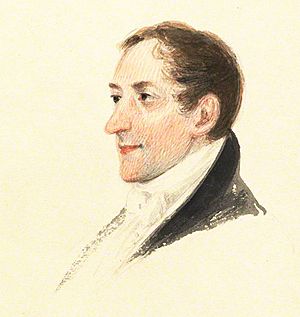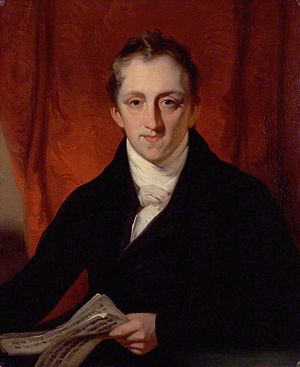H. H. Wilson facts for kids
Horace Hayman Wilson (born September 26, 1786 – died May 8, 1860) was an important English scholar. He studied the languages and cultures of the East, especially India. He became the very first Boden Professor of Sanskrit at Oxford University. This was a special job focused on teaching and researching Sanskrit, an ancient Indian language.
His Life and Work
Horace Wilson first studied medicine at St Thomas's Hospital in London. In 1808, he traveled to India to work as an assistant-surgeon for the British East India Company. This company was a powerful British trading group that also ruled parts of India.
Because he knew a lot about metallurgy (the science of metals), he was sent to work at the mint in Calcutta. A mint is a place where coins are made.
He spent many years helping to run the public education system in India. He also oversaw studies at the Sanskrit College in Calcutta. Horace Wilson strongly believed that Indian schools should continue teaching in local languages, not just English. This made him quite popular with some, but also caused some arguments.
In 1832, Oxford University chose him to be the first professor of Sanskrit. He was very proud of this and even put an advertisement in The Times newspaper listing all his achievements! A few years later, in 1836, he became the librarian for the East India Company. He also taught at the East India Company College. In 1834, he was chosen as a member of the Royal Society of London, which is a very old and respected group of scientists.
Horace Wilson was also a key member of several important groups. He was the secretary for the Asiatic Society of Bengal, which studied Asian cultures. He also helped start the Royal Asiatic Society and was its director for many years until he passed away.
He married Frances Siddons. She was the granddaughter of a famous actress named Sarah Siddons. Horace Wilson died on May 8, 1860, and was buried in Kensal Green Cemetery.
His Important Writings
Horace Wilson became very interested in India's old languages and literature. He was the first person to translate the Rigveda into English. The Rigveda is a very old collection of sacred hymns from India.
In 1813, he published a translation of a famous Indian poem called Meghadūta, or the Cloud-Messenger. He also created the very first Sanskrit–English Dictionary in 1819. This dictionary was a huge help for people wanting to learn Sanskrit. Later, other scholars used his work to create even bigger dictionaries.
He was also interested in Ayurveda, which is a traditional Indian system of medicine. He wrote about local medical practices he saw in India, especially for diseases like cholera and leprosy.
In 1827, Wilson published Select Specimens of the Theatre of the Hindus. This book explored many Indian plays and included translations of some of them. His Mackenzie Collection (1828) was a detailed list of old Indian writings and artifacts collected by Colonel Colin Mackenzie.
He also wrote other important books, including:
- A Historical Sketch of the First Burmese War (1827). This was about a war between the British and Burma.
- A Review of the External Commerce of Bengal (1830). This looked at trade in the Bengal region of India.
- A translation of the Vishnu Purana (1840). This is another important ancient Hindu text.
- A History of British India from 1805 to 1835 (1844–1848). This continued a previous history book by James Mill.
Key Publications
Here are some of Horace Hayman Wilson's most notable works:
- 1813: Meghadūta (a translation of a poem by Kālidāsa)
- 1819: Sanskrit–English Dictionary
- 1827: Select Specimens of the Theatre of the Hindus
- 1828: Mackenzie Collection (with Colin Mackenzie)
- 1840: Vishnu Purana (translation)
- 1845–48: The history of British India from 1805–1835
- 1850–88: Rig-veda Sanhitá : a collection of ancient Hindu hymns (translation)



